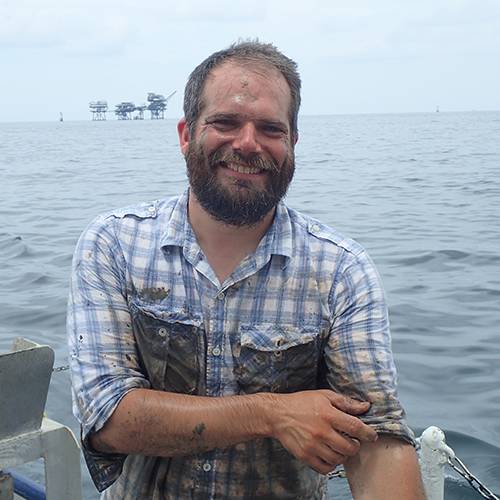Peer-Reviewed Journal Articles
Carskaddan, J.S., M.C. Rillo, P.G. Harnik, and R.A. Metzler. In press. Nacre microstructure records spatiotemporal variation in temperature in the modern ocean. Frontiers in Marine Science.
Smith, J.A. et al (125+ co-authors including P.G. Harnik). In press. Big questions in paleontology: A community-driven project to motivate new insights about the history of life on Earth. Paleobiology.
Harnik, P.G., A. Chao, K.S. Collins, and M.C. Rillo. 2024. Declining bivalve species and functional diversity along a coastal eutrophication-deoxygenation gradient in the northern Gulf of Mexico. Continental Shelf Research 282:105339.
Bright, J., C. Ebert, C. Flores, P.G. Harnik, J.W. Huntley, M. Kowalewski, R.W. Portell, M. Retelle, E.A.G. Schuur, and D. Kaufman. 2024. Comparing MICADAS gas source, direct carbonate, and standard graphite 14C determinations of biogenic carbonate. Radiocarbon 66:295-305.
Calderaro, L.A., P.G. Harnik, and M.C. Rillo. 2024. Environmental correlates of molluscan predator-prey body size in the northern Gulf of Mexico. Paleobiology 50:70-84.
Finnegan, S., P.G. Harnik, R. Lockwood, H.K. Lotze, L. McClenachan, and S.S. Kahanamoku. 2024. Using the fossil record to understand extinction risk and inform marine conservation in a changing world. Annual Review of Marine Science 16:307-333.
Mamo, B.L., J.D. Cybulski, Y. Hong, P.G. Harnik, A. Chao, A. Tsujimoto, C.-L. Wei, D.M. Baker, and M. Yasuhara. 2023. Modern biogeography of benthic foraminifera in an urbanized tropical marine ecosystem. The Geological Society of London Special Publications 529: SP529-2022-188.
Hong, Y., M. Yasuhara, H. Iwatani, P.G. Harnik, A. Chao, J.D. Cybulski, Y. Liu, Y. Ruan, X. Li, C.-L. Wei. 2022. Benthic ostracod diversity and biogeography in an urbanized seascape. Marine Micropaleontology 174: 102067.
Hong, Y., M. Yasuhara, H. Iwatani, A. Chao, P.G. Harnik, C-L Wei. 2021. Ecosystem turnover in an urbanized subtropical seascape driven by climate and pollution. Anthropocene 36:100304.
Harnik, P.G., H. Maherali, J.H. Miller, and P. Manos. 2018. Geographic range velocity and its association with phylogeny and life history traits in North American woody plants. Ecology and Evolution 8:2632-2644.
Harnik, P.G., M.L. Torstenson, and M.A. Williams. 2017. Assessing the effects of anthropogenic eutrophication on marine bivalve life history in the northern Gulf of Mexico. Palaios 32:678-688.
Hoehn, K.B., P.G. Harnik, and V.L. Roth. 2016. A framework for detecting natural selection on traits above the species level. Methods in Ecology and Evolution 7:331-339.
Finnegan, S., S.C. Anderson, P.G. Harnik, C. Simpson, D.P. Tittensor, J.E. Byrnes, Z.V. Finkel, D.R. Lindberg, L.H. Liow, R. Lockwood, H.K. Lotze, C.M. McClain, J.L. McGuire, A. O’Dea, and J.M. Pandolfi. 2015. Paleontological baselines for evaluating extinction risk in the modern oceans. Science 348:567-570.
Liow, L.H., T. Reitan, and P.G. Harnik. 2015. Ecological interactions on macroevolutionary time scales: clams and brachiopods are more than ships that pass in the night. Ecology Letters 18:1030-1039.
Orzechowski, E.A., R. Lockwood, J. Byrnes, S.C. Anderson, S. Finnegan, Z.V. Finkel, P.G. Harnik, D.R. Lindberg, L.H. Liow, H.K. Lotze, C.R. McClain, J.L. McGuire, A. O’Dea, J.M. Pandolfi, C. Simpson, and D.P. Tittensor. 2015. Marine extinction risk shaped by trait-environment interactions over 500 million years. Global Change Biology 21:3595-3607.
Harnik, P.G., P.C. Fitzgerald, J.L. Payne, and S.J. Carlson. 2014. Phylogenetic signal in extinction selectivity in Devonian terebratulide brachiopods. Paleobiology 40:675-692.
Harnik, P.G., C. Simpson, and J.L. Payne. 2012. Long-term differences in extinction risk among the seven forms of rarity. Proceedings of the Royal Society B – Biological Sciences 279:4969-4976.
Harnik, P.G., H.K. Lotze, S.C. Anderson, Z.V. Finkel, S. Finnegan, D.R. Lindberg, L.H. Liow, R. Lockwood, C.M. McClain, J.L. McGuire, A. O’Dea, J.M. Pandolfi, C. Simpson, and D.P. Tittensor. 2012. Extinctions in ancient and modern seas. Trends in Ecology and Evolution 27:608-617.
Harnik, P.G. 2011. Direct and indirect effects of biological factors on extinction risk in fossil bivalves. Proceedings of the National Academy of Sciences USA 108:13594-13599.
Harnik, P.G., and R. Lockwood. 2011. Part N, Revised, Volume 1, Chapter 24: Extinction in the marine Bivalvia. Treatise Online 29:1–24 (an online journal for the Treatise on Invertebrate Paleontology).
Harnik, P. G., D. Jablonski, A. Z. Krug, and J. W. Valentine. 2010. Genus age, provincial area and the taxonomic structure of marine faunas. Proceedings of the Royal Society B - Biological Sciences 277:3427-3435.
Harnik, P. G. 2009. Unveiling rare diversity by integrating museum, literature, and field data. Paleobiology 35:190-208.
Simpson, C., and P. G. Harnik. 2009. Assessing the role of abundance in marine bivalve extinction over the post-Paleozoic. Paleobiology 35:631-647.
Harnik, P. G., and R. M. Ross. 2004. Models of inquiry-based science outreach to urban schools. Journal of Geoscience Education 52:420-428.
Harnik, P. G., and R. M. Ross. 2003. Developing effective K-16 geoscience research partnerships. Journal of Geoscience Education 51:5-8.
Harnik, P. G., and R. M. Ross. 2003. Assessing data accuracy when involving students in authentic paleontological research. Journal of Geoscience Education 51:76-84.
Ross, R. M., P. G. Harnik, W. D. Allmon, J. M. Sherpa, A. M. Goldman, P. L. Nester, and J. J. Chiment. 2003. The Mastodon Matrix Project as an experiment with large-scale collaboration in paleontological research. Journal of Geoscience Education 51:39-47.
Simonson, B. M., and P. G. Harnik. 2000. Have distal impact ejecta changed through geologic time? Geology 28:975-978.
Edited Volumes
Harnik, P.G., and Ross, R.M., eds., 2003. Geoscience research partnerships. Journal of Geoscience Education 51(1).
